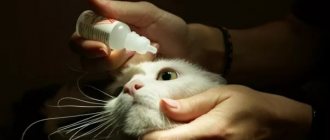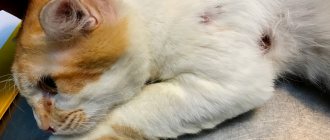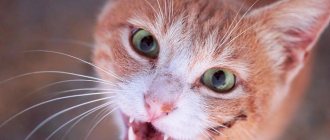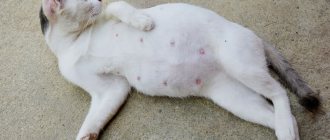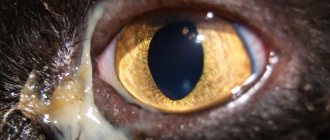Discharge from a cat's loop is a controversial phenomenon, since in some cases it can represent an absolutely normal condition, but in other situations it can be a serious signal of a problem with the pet's health. The most difficult thing in this matter is that it is quite difficult to distinguish abnormal discharge from normal discharge.
As a rule, discharge occurs normally in cats during pregnancy, the birth period, and also after it. Otherwise, if the cat is not pregnant, has not given birth or is breastfeeding, and has discharge, this is a reason to immediately consult a doctor, since the cause of such discharge can be serious illnesses, sometimes even leading to the death of the animal.
Cat has brown discharge
Vaginal discharge is any substance (such as blood, mucus, pus) that comes out of the vagina through the opening of the vulva.
Ideally, in a healthy cat, vaginal discharge is the result of a natural physiological process in which the secreted mucus lubricates the walls of the internal genital organs and protects them from infections. In the presence of pathology, the color, smell, quantity and consistency of the lubricant change, which allows timely detection of the problem before it worsens.
Free consultation Moscow
+7(495)162-70-70
In some cases, bloody and mucous discharge is normal, but in other cases it is a symptom of inflammation, infection, etc.
- Secretions consisting of serum and blood
Normal – during early estrus, “proestrus” stage; sometimes during “estrus” or in the “estrus” stage.
- Discharge containing blood, mucus and tissue debris (lochia) and other discharge
Normal – postpartum discharge for 6-8 weeks
- Discharge containing pus
Normal – at the beginning of “diestrus” there is a small amount of discharge
Diseases of the reproductive organs
Mucous, cloudy, brown discharge is a sign of glandular cystic endometrial hyperplasia (GCGE). The pathology is caused by hypersecretion of the uterine glands, obstruction of the excretory ducts, and the presence of cysts.
When examining the animal, the following is revealed:
- vulva enlargement
- poor condition of the female
- lethargy, apathy
- lack of appetite
- drinking a lot of water
- dull coat
- enlargement and density of the uterine horns
Mucopurulent excretion can be observed in the purulent form of vulvitis and vaginitis, as a result of penetration of pathogenic bacteria and fungi into the tissues of the vulva and vagina.
Bloody, pus-like discharge from the vagina is a sign of acute endometritis, which, if left untreated, can develop into a more serious form - pyometra.
Pus from the loop is an alarming symptom indicating an inflammatory process in the uterine cavity (open form of pyometra), which can result in the death of the pet. The secreted contents have a yellowish-green or brown tint. Sometimes the discharge becomes heavy and then stops for several days.
Condition of the female:
- general weakness, immobility
- decreased appetite and body weight
- thirst
- nausea, vomiting
- frequent urination
- temperature over 40˚С
- the stomach is enlarged and tense
Contents from the genital slit of a whitish, yellow-green, dark brown hue indicate the presence of a chronic form of endometritis, which developed as a severe consequence of GCGE as a result of the penetration of bacteria from the external genital tract into the uterus.
The general condition of the female is unchanged, but with a complicated course, depression, refusal to feed, increased water consumption, and frequent urination are observed.
Vaginal discharge can occur during prolonged estrus, which is also a pathology and requires examination by a specialist.
Causes of discharge in cats
There are many risk factors that can lead to vaginal discharge:
- vaginal trauma;
- vaginal infection;
- urinary tract infection;
- abnormal cells in the vaginal area;
- preserved placenta after childbirth;
- death of the fetus in the womb;
- the presence of a foreign object in the vaginal cavity;
- estrogen medications prescribed during certain phases of the cat's estrus or estrous cycle; medications;
- certain antibiotics, which may cause vaginal discharge;
Since there are so many causes of this disease, it is recommended to consult a veterinarian if any type of discharge is detected.
Additional symptoms
For different diseases, the following are possible:
- increased and/or difficulty urinating, which is painful and can therefore cause anxiety and even aggression;
- it’s hard for the poor thing to go “big”;
- for a long time the cat rubs its butt on the floor (or rolls on the floor);
- licks himself from behind too often, because the discharge irritates the skin;
- complete apathy; drowsiness; vomit; fever; increased thirst; poor appetite; abdominal enlargement.
Diagnosis
If, when examining a sick cat, the veterinarian finds blood, pus, urine or feces in abnormal quantities, the veterinarian will need to review the cat's medical history and conduct a risk assessment.
A thorough medical examination of the cat is required to make an accurate diagnosis.
Call a veterinarian Moscow
+7(495)162-70-70
- Blood tests
- General urine analysis
- Vaginoscopy
- Vaginal cytology
- Biopsy
- X-ray
- Ultrasound
Cats Pyometra (Purulent inflammation of the uterus) Vetna
Cats, just like people, unfortunately suffer from various diseases.
One of the dangerous diseases in our pets is pyometra. It is cats, not cats, who suffer from this disease, because pyometra is an inflammation of the walls of the uterus, in which pus accumulates in the uterus itself and its horns. This disease is very dangerous because if you do not take action in time and do not take the cat to the veterinarian, there can be so much pus in the uterus that the uterus simply cannot stand it and bursts and all the pus spills into the abdominal cavity and then, unfortunately, there is a high probability that your pet will die in no time. There are several reasons why your cat may get pyometra: - if you decide to breed her with a cat to produce offspring and have not checked whether this cat is healthy or not. To reduce the risk, it is better to check the cat, because he may have some sexually transmitted diseases; — if you decide to give your cat various hormonal drugs, thanks to which your cat will not scream during estrus. These drugs will certainly make your life easier, but they can also be dangerous; it is better not to use them. However, if you still decide to give your cat such drugs, consult with your veterinarian which drugs are suitable for your pet; - if the cat has some kind of hormonal imbalance, its body is weakened, and neoplasms (cysts) have appeared in the uterus. These are the main causes of pyometra in cats. It is also known that this disease more often appears in old and middle-aged cats. However, young individuals can also get sick. What are the symptoms of this disease you ask. After all, you won’t be taking your cat to the veterinary clinic very often. This is a lot of stress for the animal, and the examination also costs money, because pyometra is best seen on an ultrasound. Symptoms of pyometra in a cat: - large, swollen belly. You may think that your pet is pregnant; - the cat has ceased to show interest in food; - the animal is hot. Although cats naturally have a higher temperature than humans, you can determine whether its temperature has increased or not simply by touching its ears and nose. If they are hotter than always and the cat is not lying in the sun or radiator at that moment, then most likely she has an elevated temperature, which means she has inflammation; - Your pet has suddenly become lethargic, does not react to anything, does not want to play; — Have you noticed that the cat often licks itself under its tail? Sometimes this happens so often that even bald spots form there. It is also possible that purulent discharge may appear, although this is not necessary. - Your pet has developed an unnatural thirst that is not inherent to her. The cat drinks water very often and pees often. If you notice several of these symptoms in your cat, immediately take her to the veterinary clinic, because the sooner treatment begins, the greater the chance that the cat will recover. There are two ways to cure pyometra: medication and surgery. However, please note that only a veterinarian, after a thorough examination of your pet, can prescribe treatment. Never self-medicate, you can make things worse for your cat. Trust the veterinarians, they will conduct urine and blood tests, look at the cat for an ultrasound, and only then will they be able to correctly prescribe treatment. Most often, in the case of pyometra, veterinarians suggest surgery to remove the uterus and horns. Usually such operations are successful, and the cats survive and recover. The most unpleasant thing about the operation is general anesthesia. Unfortunately, there is a small chance that the kitty may not wake up after it. However, these are rare cases. Also keep in mind that after the operation your pet will never have offspring again. There is another way of treatment - with the help of medications. Of course, in this case, after treatment, the cat will be able to produce offspring, since its uterus will be in place. However, this method may not be particularly effective, and relapses are possible. Which method to choose is of course up to you and your veterinarian, but there is a high probability that you will have to choose surgery. And some more food for thought: if you never intend to breed your cat, veterinarians recommend spaying her at a young age before her first heat to avoid the possibility of her developing pyometra.
Prevention
In order for the process of bearing offspring in your animal to go smoothly, it is important to carry out preventive measures in a timely manner. Moreover, it is better to carry out some of them not at the moment when mating occurs, but throughout the entire life of the animal.
Monitor the animal’s health, get all the necessary vaccinations on time and select the right food, taking into account all the parameters. It would also be a good idea to have periodic checkups with a veterinarian.
After mating, you should carefully monitor the condition of the animal and pay attention to even the smallest changes.
- All the veterinarian's instructions must be followed very carefully.
- During pregnancy, you should protect your pet from cold, drafts and dampness.
- For mating, you should choose a healthy partner who has all the necessary vaccinations.
It is important that mucous discharge can also appear in a sterilized cat a short time after surgery. They have a slimy consistency and yellow color, but do not have a strong odor. If such discharge does not stop for a long time, then you should show your pet to a veterinarian, as inflammatory processes are likely to develop.
Proper care and following all doctor’s recommendations will help your cat have a normal pregnancy and give birth to healthy kittens. It is important for the owner only to pay attention to the condition of the pet, and everything else will happen by itself.
This article has been checked and approved by a veterinarian. Knyazeva Anna Vladimirovna, veterinarian in private practice, Moscow. more about the expert.
(you can vote for the article)
Tags: cat pregnancy, cat discharge, cat
- Related Posts
- A cat eats kittens - why?
- What does dark discharge from a cat’s eyes indicate?
- Answers to the owner’s “why”: Chihuahua and everything about it!
Pathological discharge
Even non-specialists understand that bloody watery masses are the most obvious sign of problems with pregnancy. The most dangerous is the light red mucus, which appears every 10–15 minutes, and more than 2 tablespoons comes out at a time. This is already a sign of internal bleeding, which requires surgical intervention. After all, most often such bleeding occurs when the uterus ruptures, which can even be fatal.
Brown or yellow discharge interspersed with blood at the 2nd stage of pregnancy indicates placental abruption or the death of embryos. It is necessary to contact a veterinarian because there are many different options in this situation. For example, if the placenta detaches at a fairly late stage, then the pregnant cat is prescribed additional diagnostics. These are various tests and ultrasound. In the absence of serious problems, constant monitoring is recommended, but, most likely, the pregnancy will end naturally.
If fetal death occurs, there are 3 main treatment options:
- causing premature birth,
- drug therapy,
- surgical intervention.
If a pregnant cat has yellow or green discharge with a strong and unpleasant odor, then one or more embryos have died. Mucus of this color appears when decomposition has already begun. In addition, yellow or green discharge may indicate intoxication in the animal’s internal organs and kidney failure. In these situations, urgent caesarean section or induction of labor is necessary. After this, the cat will have to go through a long period of rehabilitation.
The owner of the animal needs to be careful not to confuse diarrhea with yellow and brown discharge. But at the same time, you should not delay the treatment of such disorders of the digestive system, since in the future even the most minor diseases can affect the health of kittens.
Discharge is normal
Immediately after conception, the pet develops pink mucus. This is completely normal if mating occurs during estrus. You just need to pay attention to the intensity of such secretions; there should not be too much mucus. The smell and absence of blood are also important. There should not be a strong or unpleasant aroma. Otherwise, you should take your cat to a veterinarian to determine the cause of the problem.
Until approximately the 4th week of pregnancy, that is, until the uterus closes, unfertilized “extra” eggs may be present in the mucus. In cats, they appear as lumps that are a bit like leeches in appearance. You should not be afraid if such inclusions are present in your pregnant cat’s discharge. This process suggests that the flora in the cat’s uterus is sterilely clean, which means there are no inflammatory processes.
Discharge at different stages of pregnancy
The entire period of gestation of kittens is divided into 3 stages:
- 1–3 weeks – early,
- 4–6 weeks – fetal development,
- 7–9 weeks prenatal.
The most serious problems during pregnancy can appear in stages 1 and 3. And at the 2nd stage, only the growth of kittens in the mother’s womb occurs, and no important organs and systems are formed. During this period, no mucous secretions should appear in the pregnant cat. But there are situations in which discharge occurs and it is a variant of the norm, but this is rare. The problem is often that the animal licks itself frequently and well, so the owner may miss the appearance of discharge, especially white or yellow.
At the first stage, watery red discharge may be present, since at this time the embryo attaches to the uterus, and this causes injury to the mucous membrane. But at about 4 weeks, the uterus of a pregnant cat closes, and after this only light, colorless discharge is possible, which comes out along with the urine and is therefore practically invisible. These discharges may also have a yellow color, but not bright, but muted. Any other watery masses during this period signal problems with pregnancy.
At the 3rd stage, the body begins to prepare for childbirth. About a day before giving birth (but not earlier), noticeable mucous clots may appear. This is due to the rejection of the mucous membrane and indicates that everything will begin soon. Typically, in pregnant cats, mucous membrane rejection begins the moment the first kitten begins to move. Most often during this period, a pregnant cat has yellow discharge, less often - green. After active contractions, the color of the discharge turns from yellow to transparent, sometimes it contains splashes of blood.




